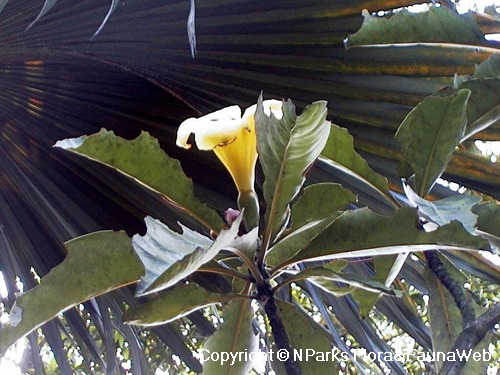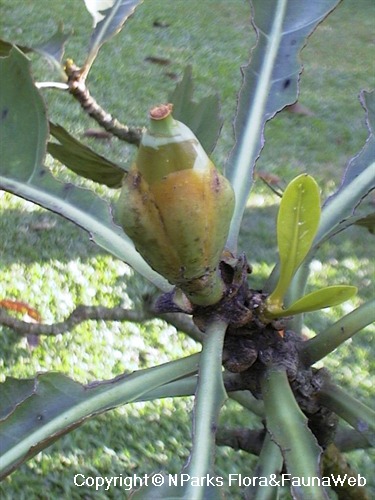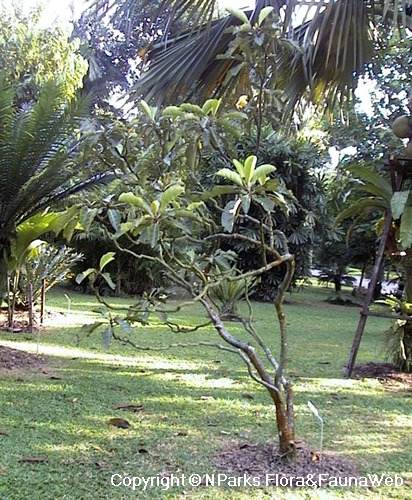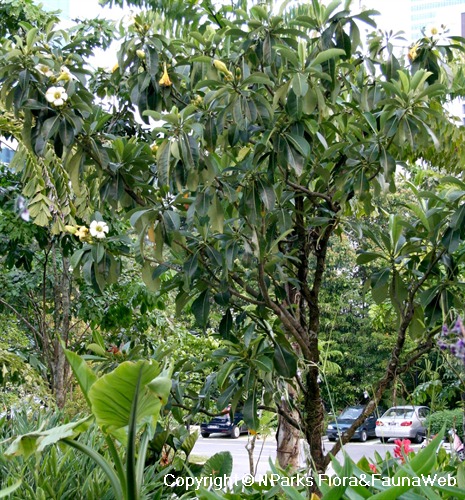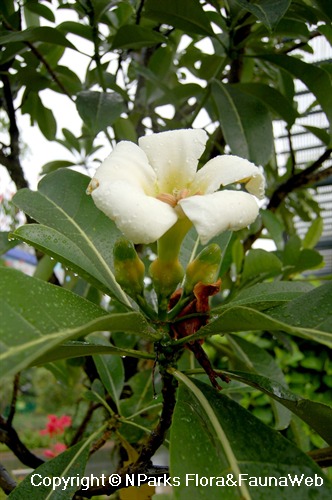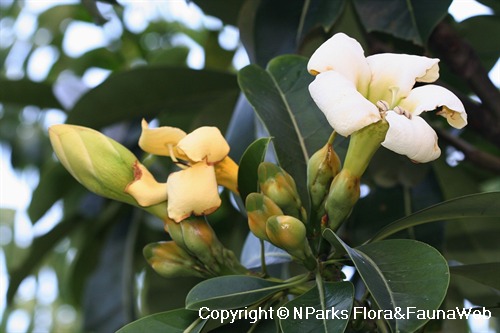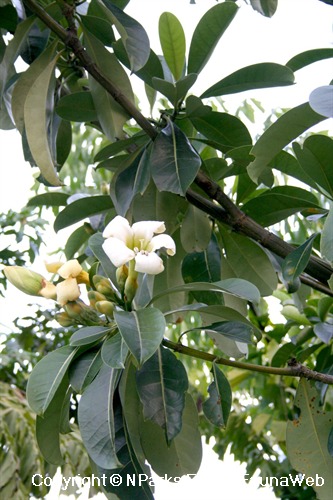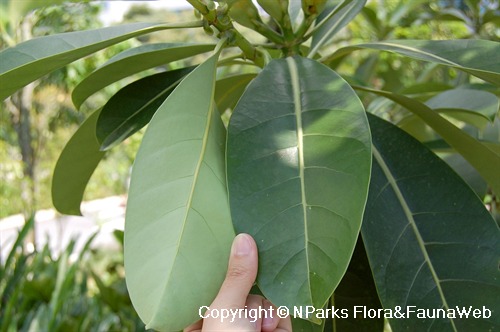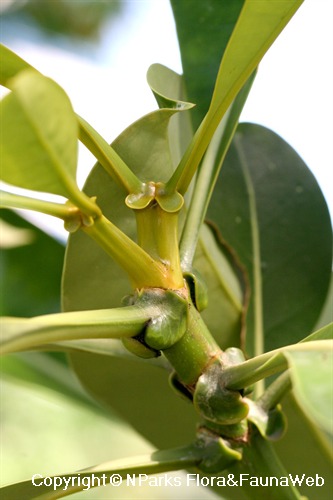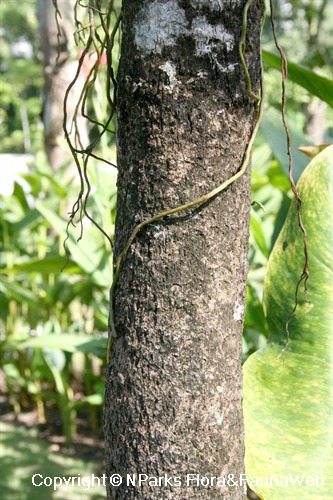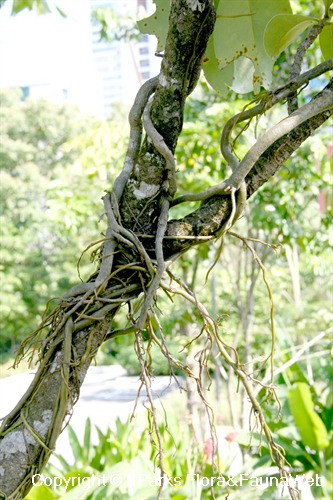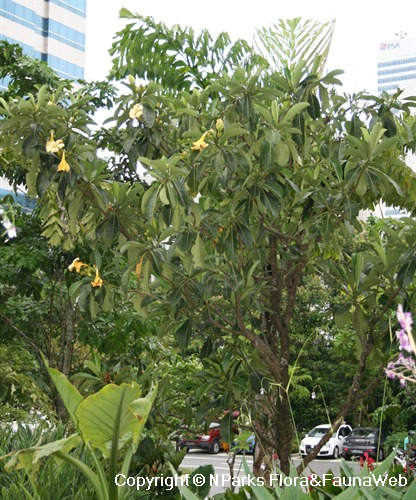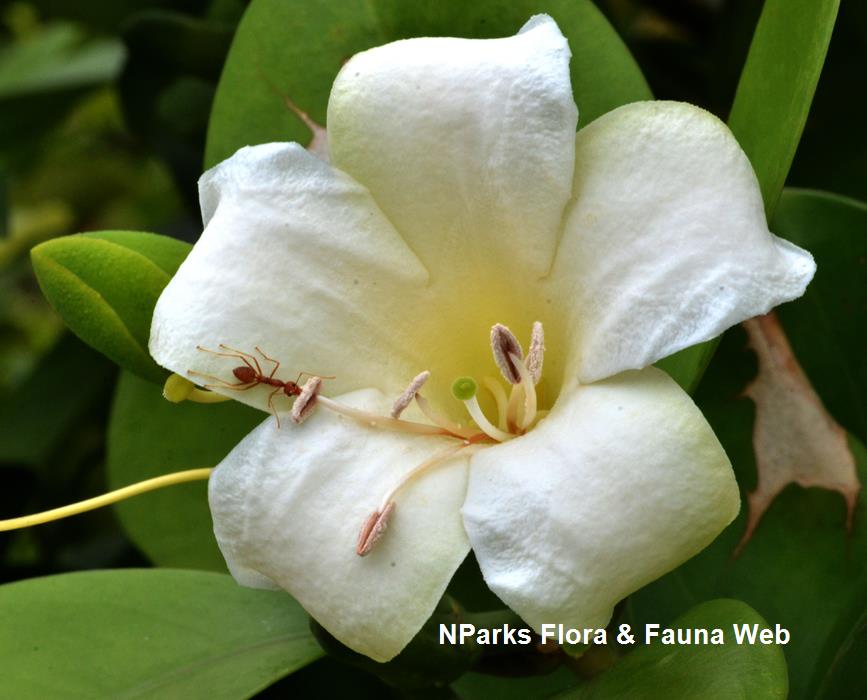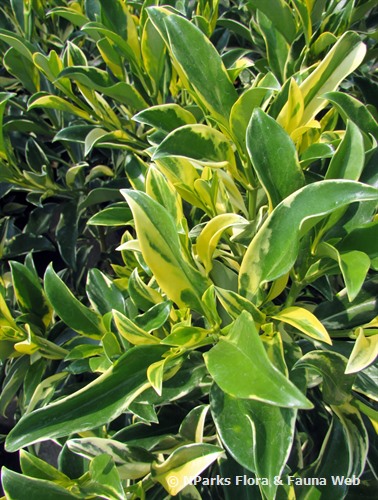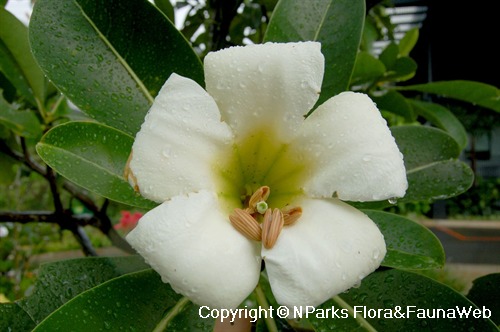
Name
Classifications and Characteristics
| Plant Division | Angiosperms (Flowering Seed Plants) (Dicotyledon) |
|---|---|
| Plant Growth Form | Shrub, Tree (Shrubby (1m-5m)), Epiphyte |
| Lifespan (in Singapore) | Perennial |
| Mode of Nutrition | Autotrophic |
| Plant Shape | Irregular, Open |
| Maximum Height | 20 m |
Biogeography
| Native Distribution | South Myanmar, Thailand, Cambodia, Sumatra, Peninsular Malaysia, Singapore, the Philippines, Borneo, Java, Bali, Moluccas, and through the rest of Southeast Asia to New Guinea |
|---|---|
| Native Habitat | Terrestrial (Coastal Forest), Shoreline (Coastal Cliff) |
| Preferred Climate Zone | Tropical, Sub-Tropical / Monsoonal |
| Local Conservation Status | Native to Singapore (Critically Endangered (CR)) |
Description and Ethnobotany
| Growth Form | It is a small tree to large terrestrial shrub (5–18 m tall) or hemi-epiphyte. |
|---|---|
| Foliage | Its opposite, stalked leaves have leathery leaf blades that are reverse lance-shaped or egg-shaped, and 9–60 by 4–25 cm, with two auricles at base of the leaf stalk. |
| Flowers | Its large, tubular, fragrant flowers develop singly, or in small clusters, maturing from white to cream to yellow, and may grow up to 30 by 30 cm. |
| Fruit | Its fruits are oblong-ellipsoid to ovoid, greyish-white when ripe, and 6–15 cm long. Its tiny seeds are embedded in the fleshy fruit pulp. |
| Habitat | It grows in coastal forests, on cliffs and rocks. It occurs locally at Pulau Tekukor and Pulau Pawai. |
| Cultivation | It can be propagated by seed, root cuttings, stem cuttings and air-layering. |
| Etymology | Latin Fagraea, commemorating John Theodores Fagraeus (1729–1797), a Swedish physician and botanist; Latin auriculata, lobed like an ear, referring to the pair of lobed stipules at the base of the leaf stalk. |
| Ethnobotanical Uses | Medicinal: Bark used to treat ulcers. Others: Sticky substance under fruit epidermis used as glue in Sumatra. |
Landscaping Features
| Landscaping | It is suitable for streetscapes, parks and gardens for its attractive, large flowers, thick leaves, and tolerance to hot and dry conditions. |
|---|---|
| Desirable Plant Features | Ornamental Flowers, Fragrant (Flowers) (Day, Dawn / Dusk), Ornamental Foliage |
| Landscape Uses | Coastal, General, Suitable for Roadsides, Parks & Gardens, Small Gardens, Focal Plant |
| Thematic Landscaping | Fragrant / Aromatherapy Garden, Water Garden, Naturalistic Garden |
Fauna, Pollination and Dispersal
| Fauna Pollination Dispersal Associated Fauna | Bird-Attracting |
|---|---|
| Pollination Method(s) | Biotic (Fauna) (Insects (Ant, Beetle, Fly, Thrip, Wasp), Vertebrates (Bird), Insects (Bee)) |
| Seed or Spore Dispersal | Biotic (Fauna) |
Plant Care and Propagation
| Light Preference | Full Sun |
|---|---|
| Water Preference | Moderate Water, Little Water |
| Plant Growth Rate | Slow |
| Rootzone Tolerance | Fertile Loamy Soils, Well-Drained Soils, Saline Soils / Salt Spray, Drought Tolerant, Moist Soils |
| Maintenance Requirements | Moderate |
| Propagation Method | Stem Cutting, Air-Layering, Seed, Root Cutting |
Foliar
| Foliage Retention | Evergreen |
|---|---|
| Mature Foliage Colour(s) | Green |
| Mature Foliage Texture(s) | Leathery, Thick |
| Foliar Type | Simple / Unifoliate |
| Foliar Arrangement Along Stem | Opposite |
| Foliar Attachment to Stem | Petiolate |
| Foliar Shape(s) | Non-Palm Foliage (Oval, Obovate) |
| Foliar Venation | Pinnate / Net |
| Foliar Margin | Entire |
| Foliar Apex - Tip | Cuspidate |
| Foliar Base | Acute |
| Typical Foliar Area | Notophyll ( 20.25cm2 - 45 cm2 ) |
| Leaf Area Index (LAI) for Green Plot Ratio | 3.0 (Tree - Intermediate Canopy) |
Non - Foliar and Storage
| Trunk Type (Non Palm) | Woody |
|---|---|
| Mature Bark Texture | Scaly |
| Stem Type & Modification | Woody |
| Root Type | Underground (Tap Root, Fibrous Root), Aboveground (Aerial Root) |
Floral (Angiosperm)
| Flower & Plant Sexuality | Bisexual Flowers |
| Flower Colour(s) | Cream / Off-White, White, Yellow / Golden |
|---|---|
| Flower Grouping | Cluster / Inflorescence |
| Flower Location | Terminal |
| Flower Symmetry | Radial |
| Individual Flower Shape | Trumpet-shaped |
| Flower Size - Remarks | Large, 30cm long by 30cm wide |
| Flowering Opening Time | Time-Independent |
| Flower Lifespan on Plant | 1 Day |
| Flowering Habit | Polycarpic |
| Inflorescence Size Remarks | Flower matures from white to cream to yellow. |
| Flowering Period Remarks | Yearly, June - July |
Fruit, Seed and Spore
| Mature Fruit Colour(s) | Silver / Grey |
|---|---|
| Mature Fruit Texture(s) | Glossy / Shiny, Waxy |
| Fruit Classification | Simple Fruit |
| Fruit Type |
Image Repository
Others
| Master ID | 717 |
|---|---|
| Species ID | 2012 |
| Flora Disclaimer | The information in this website has been compiled from reliable sources, such as reference works on medicinal plants. It is not a substitute for medical advice or treatment and NParks does not purport to provide any medical advice. Readers should always consult his/her physician before using or consuming a plant for medicinal purposes. |

